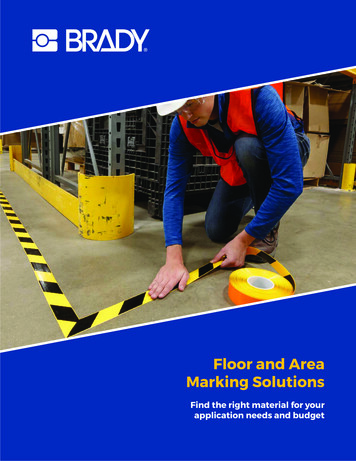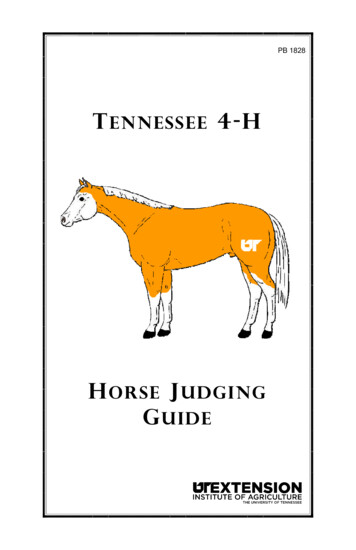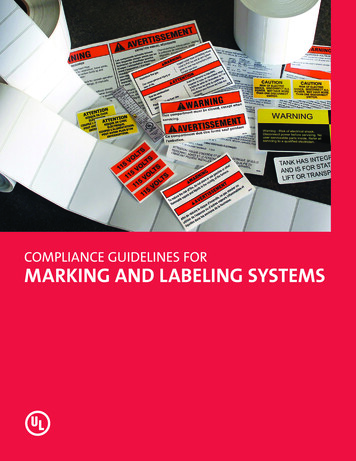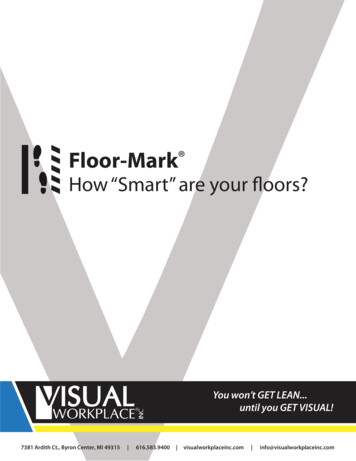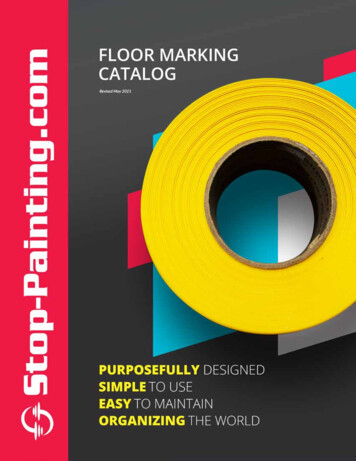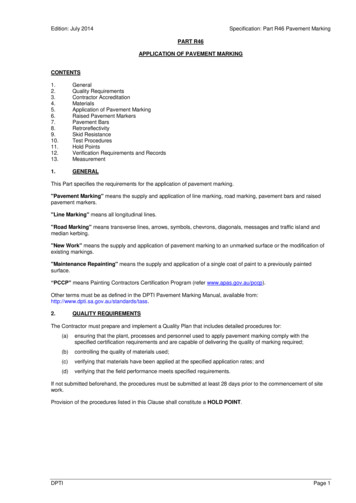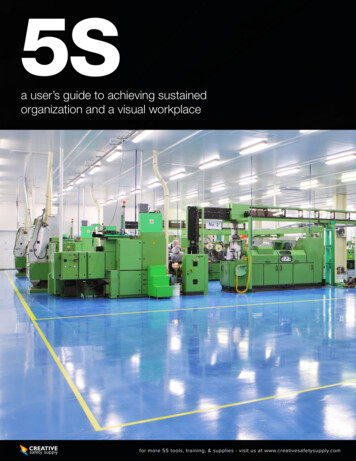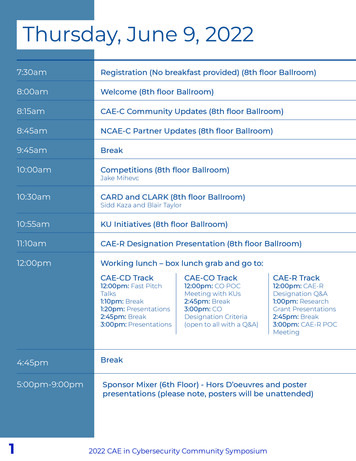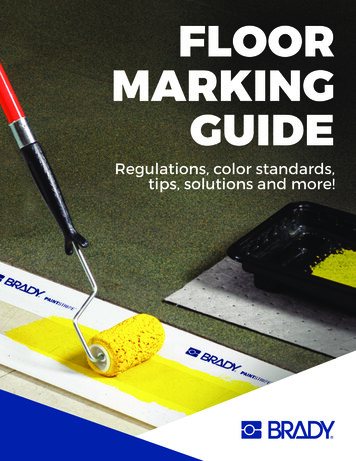
Transcription
FLOORMARKINGGUIDERegulations, color standards,tips, solutions and more!
Floor marking plays an important role in creating and maintaining asafer, leaner and more efficient facility. In this guide, you'll learn aboutthe benefits of establishing a consistent color standard for floor marking,receive tips and a color guide for implementing a standard, and gainadditional insight through floor marking examples and solutionrecommendations.Chapter 1: Benefits of Color-Coded Floor Marking. 3Chapter 2: Regulations and Industry Standards. 5Chapter 3: 9 Tips for Effective Floor Marking.6Chapter 4: Color Standards Guide.8Chapter 5: Floor Marking Examples.9Chapter 6: Getting the Job Done Right. 11
CHAPTER 1Benefits of Color-Coded Floor MarkingUsing consistent, color-coded floor marking in your workplace can lead to anumber of benefits. Let’s take a look at a few:Leaner, More Efficient OperationsWhen you have a consistent floor marking color system, employees are ableto associate certain colors with certain areas or actions. This allows them toquickly and easily move around the facility to complete their tasks and findwhat they’re looking for. Using color in the workplace helps to:1. S peed Visual Search: When you are looking for a certain materialstorage area, knowing what color floor marking to look for helpsyou find it faster.2. E mphasize Information: Marking aisleways and exit pathsthroughout your facility helps to emphasize the safest path towalk through. This helps to keep pedestrians and forklifts safe,and provide quick egress guidance in an emergency.3. S how Associations: If you mark a cart with a certain color tape orpaint, and also mark off the area the cart belongs in with thesame color tape or paint, you can easily associate the cart withits intended location.4. T ransmit Important Messages: Hazards that are consistentlymarked with bright colors (red/yellow) quickly tell employees thatthe area is unsafe or should be kept clear.Chapter 1 / 3
CHAPTER 1Benefits of Color-Coded Floor MarkingImproved SafetyBy using a standard color-coding for floor tape and paint, you can easilywarn workers at-a-glance of hazardous areas, equipment or forklift trafficpaths. Workplace safety is improved when employees are visually aware ofunsafe areas that should be kept clear, items are stored in their designatedareas to reduce trip hazards, safe walking paths are marked, and exit routesare clearly marked.Beyond Floor MarkingWhen establishing a safer, more efficient workplace, other key visuals include: ANSI Safety Signs HazCom/GHS Labels F ire, Emergency Egress and FirstAid Identification L ockout Tagout Equipmentand Labels M achine and EquipmentIdentification Arc Flash Labels Pipe Markers Inventory LabelsVisit BradyID.com/5SPlusGuide to learn more.Chapter 1 / 4
CHAPTER 2Regulations and Industry StandardsWhen it comes to workplace visuals, there are a number of relevantstandards that require or imply the need for marking and color coding:OSHA - Use of Mechanical Equipment1910.176(a) Where mechanical handling equipment is used, sufficient safeclearances shall be allowed for aisles, at loading docks, through doorwaysand wherever turns or passage must be made. Aisles and passageways shallbe kept clear and in good repair, with no obstruction across or in aisles thatcould create a hazard. Permanent aisles and passageways shall beappropriately marked.OSHA - General Environmental Controls1910.144 Red shall be the basic color for the identification of fire protectionequipment and apparatus, containers of flammable liquids, stop buttonsand electrical switches used for emergency stopping of equipment.1910.144(a)(3) Yellow shall be the basic color for designating caution andmarking physical hazards.OSHA - Means of Egress1910.35 OSHA will deem an employer demonstrating compliance with theexit route provisions of NFPA 101, Life Safety Code, or the exit route provisionsof the IFC 2009, to be in compliance with 1910.34, 1910.36 and 1910.37.OSHA - Letter of Interpretation1910.22(b) The lines used to delineate aisles may be any color so long as theyclearly define the area considered as aisle space. The lines may be composedof dots, square, strip or continuous. The recommended width of aislemarkings varies from 2” to 6”, therefore any width 2” or more isconsidered acceptable.Chapter 2 / 5
CHAPTER 2Regulations and Industry StandardsIFC - International Fire Code 20091024.1 Approved luminous egress path markings delineating the exit pathshall be provided.having occupied floors located more than 75 ft. above thelowest level of fire department vehicle access.1024.2.1 A solid and continuous stripe shall be applied to the horizontalleading edge of each step and shall extend the full length of each step.1024.2.4 Perimeter and floor mounted demarcation lines shall be placedwithin 4” of the wall and extend to within 2” of the markings on the leadingedge of landings. Demarcation lines shall be 1” to 2” wide with interruptionsnot exceeding 4”.Chapter 2 / 6
CHAPTER 2Regulations and Industry StandardsWhile several OSHA regulations dictate that permanent aisles andpassageways must be clearly marked, there are no currentgovernment-mandated or even widely accepted industry standards thatrecommend what colors to use when marking floors.ANSI Color Guide – Safety SignageSome suppliers reference the ANSI Z535.1 Safety Color Code standard as aguide for floor marking. While earlier versions of the standard (ANSIZ353.1-1998) did include color specifications for specific types of safetyhazards and equipment, these specifications were removed from the 2002edition of the standard and no longer represent ANSI recommended bestpractices. Section 4.2 of the standard explicitly states that the specificationsare intended for use on safety signage, not for floor marking.OSHA Color Guide – HazardsSome resources also reference OSHA standard 29 CFR 1910.144, the SafetyColor Code for Marking Physical Hazards. However, these specifications areextremely limited in scope and are not designed to provide guidance oncolor usage when marking floors either. The standard states that red shouldbe used to identify fire protection equipment, emergency stop devices andcontainers holding dangerous materials. Yellow should be used for markingphysical hazards (such as striking against, stumbling, falling, tripping andcaught-in-between hazards).Chapter 2 / 7
CHAPTER 39 Tips for Effective Floor Marking1. Use as few colors as possible. his makes it easier for employees to remember the meaning of eachTcolor and reduces the number of floor marking products in inventory.(Chapter 4 has recommendations on just what colors to use where!)2. Color-code workcell and equipment borders. ome companies choose to mark equipment locations using the sameScolor that’s used for aisleways and work-cell boundaries. This has thebenefit of simplicity. However, the overall layout of lanes and sectorswithin the plant is made more visually clear when different colors areused for these purposes.3. Color-code material storage areas. se the same border color for all material storage areas, unless there isUan important reason for differentiating between raw materials, workin-progress and finished goods. As an alternative, consider using oneborder tape or paint color in conjunction with different colored labels tovisually distinguish between the various material types.4. Color-code non-material storage fixtures. loor markings for fixtures, such as racks that hold raw materials, workFin-progress or finished goods, should be color-coded in green, blueand/or black. Otherwise use white or gray to mark the location of allother fixtures.Chapter 3 / 8
CHAPTER 39 Tips for Effective Floor Marking5. Color-code areas to be kept clear for safety and compliance. ome companies use red or red and white stripes in front of firefightingSequipment, and green or green and white stripes in front of safetyequipment. For simplicity sake, we recommend using one color for allapplications where the intent is to keep the area in front of equipmentclear for safety or compliance reasons. We also recommend that thefirefighting and safety equipment itself - as well as any associated wallsignage - be color-coded to enhance visibility and facilitate easy locationof the equipment from a distance.6. Color-code areas in front of electrical panels.R ed and white should also be used to mark the floor in front of electricalpanels. Some facilities use black and yellow to indicate the presence of anelectrical hazard, but the primary purpose of the marking is to keep the areain front of the panel clear. Danger labels should be displayed on the outsideof the panels to warn employees of potential shock and arc flash hazards.7. Color-code operational “keep clear” areas. se black and white marking to indicate that an area should be keptUclear for operational reasons, such as ensuring sufficient clearance forforklifts. As objects without a home tend to naturally congregate in openareas, employ black and white marking to discourage the use of openfloor space for unintended purposes.Chapter 3 / 9
CHAPTER 39 Tips for Effective Floor Marking8. Color-code hazardous areas or equipment. lack and yellow striped marking should be used as a border around anyBarea or piece of equipment where employees may be inadvertentlyexposed to a special hazard. For example, use black and yellow bordersaround flammable material containers. The intent of the black and yellowborder is to indicate that special caution should be exercised whenentering and working in the area.9. Mark means of egress. or buildings 75 ft. and higher above ground level, use luminous egressFpath markings on steps and floors to delineate exit pathways. That wayworkers and visitors can locate exit paths in low light if an emergencyoccurs.Chapter 3 / 10
CHAPTER 4Color Standards GuideWith the right colors in the right places, you can easily keep workers on theright path, identify equipment and storage areas, hazardous flooring andforklift traffic and more.Implement this useful guideline to establish floor marking consistency inyour workplace:ColorAreaYellowAisle ways, traffic lanes and work cellsWhiteEquipment and fixtures not otherwise color coded(workstations, carts, floor stand displays, racks, etc.)Blue, Greenand/or BlackMaterials and components, including raw materials,work-in-progress and finished goodsOrangeMaterials or products held for inspectionRedDefects, scrap, rework and red tag areasPhotoluminescentSteps and perimeter demarcation to identify egressroutes in a lights-out emergencyRed and WhiteAreas to be kept clear for safety/compliance reasons(areas in front of electrical panels, firefightingequipment and safety equipment, such as eyewashstations, safety showers and first aid stations)Black and WhiteAreas to be kept clear for operational purposes(not related to safety and compliance)Black and YellowAreas that may expose employees to special physicalor health hazardsChapter 4 / 11
CHAPTER 5Floor Marking ExamplesAisleways andtraffic lanesWorkcellsEquipmentMaterialstorage areasMaterialstorage areasMaterialstorage areasQAinspectionDefects/scrap/reworkChapter 5 / 12Photoluminescentstair marking
CHAPTER 5Floor Marking ExamplesKeep clear safetyKeep clear eaDID YOU KNOW?People make a subconscious decision about their environmentwithin 90 seconds of initial viewing – 62-90% of thatassessment is based on color alone.** Morton, J. (2010). Why Color Matters.Retrieved from rsChapter 5 / 13
CHAPTER 6Getting the Job Done Right!Armed with the knowledge of which floor marking colors to use for whatareas, the next step is finding the products to get the job done right. Hereare a few features to consider when selecting your materials: D urability: When you have durable floor marking tape or paint, you spendless time and money replacing damaged or worn lines. Look for a tape orpaint product that can withstand forklift traffic, has a low-profile design tominimize tears and scratches from skids, pallets and other threats. Ruggedpolyester tape and ultra-aggressive adhesive are key features for durability,while paint is another durable option. E asy Application: The right tape and paint can easily be applied insmooth, straight lines without the help of co-workers. Stiff polyester tapewith liners helps to prevent tape from stretching, which reduces wrinkles,waves and lines. Also, look for a material that allows for clean removalwithout any adhesive residue or damage to the floor. Using paint andstencils also enables easy, effective application. Visibility: Tape and paint can provide effective visibility with a brightprotected finish, a variety of high-impact colors and a surface that resistsmarks and smudges. S hape Options: Floor tape and paint are not always one-size fits all. Find atape option or stencils that allow for dots, arrows, dashes, footprints,corners and other die-cut shapes. This gives you the flexibility and varietyyou need for any floor marking application.Brady offers floor marking solutions to meet your durability, application andbudget needs. These include ToughStripe Max, ToughStripe and B-726 vinylmarking tape, as well as PaintStripe Floor Marking Stencils.To learn more, visit BradyID.com/toughstripeChapter 6 / 14 2018 Brady Worldwide Inc. ALL RIGHTS RESERVED
Floor marking plays an important role in creating and maintaining a safer, leaner and more efficient facility. In this guide, you'll learn about the benefits of establishing a consistent color standard for floor marking, receive tips and a color guide for implementing a standard, and gain
